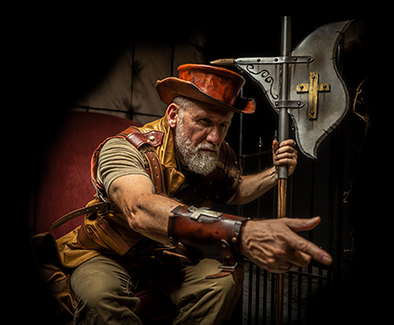Leather Journal Tutorial
Measuring
The first thing you’ll need is materials. To figure out how much material is needed, measure your blank journal. For this example, I am using a composition book. They are easy to find and inexpensive.
The easiest way to measure is using a tailor’s tape. If you don’t have one you can find them easily at craft stores. Alternatively, you can use a string and then measure the string afterward.
With the journal closed, measure from the long end from the front around the spine to the back edge. In my case, it measures 15 1/4 inches. Now measure the height of the journal. For this, you can use any measuring tool. Mine is 9 ¾ inches.
To hold the cover on, you will need to sew flaps on the inside for the journal to slide into on each long end. You will need to add a seam allowance to make room for the stitching as well as some extra to accommodate the thickness of the journal cover so it slides on easily. Three-eighths to a half-inch is plenty for stitching. You will add that to all four sides of the cover. In my example, it would be 15 1/4 + 3/8 + 3/8 which equals 16 inches for the width. The height would be 9 ¾ + 3/8 + 3/8 which equals 10 1/2 inches. So, the dimensions for the outside cover are 16 wide by 10 1/2 high.
We also will need to figure out the flaps. They shouldn’t be too wide, or it is hard to get the journal on the cover without damaging the spine. For most journals, two and a half to three inches is more than wide enough. Add your seam allowance to the top and bottom and just the one 3/8 to half-inch to the width as it only gets sewn on the one long side. So, my flaps, by way of example, are 10 1/2 by 3 3/8 wide. You will need two of these.
Materials
I am a leatherworker, so that’s my primary medium. It’s very durable, sustainable, and will last a lifetime if properly cared for. You can source the leather from a Tandy Leather store, online sources, or you can even buy a thrift store leather coat and harvest the leather from that. (You might need to sew some of it together to get the right width.) You can also choose other materials such as various fabrics, cork, or faux leather.
It is important that it’s a material you like. Regardless of the material, the construction is essentially the same. For the purposes of the project, I will show you how to do this by hand in leather—just like our ancestors would have. We often learn much by going “old school.”
Decoration
You might want to decorate or embellish your journal. Maybe you want to add a monogram, or pocket to hold writing instruments. Maybe you want nice decorative corners. Whatever strikes your fancy. Leather can be dyed, painted, embossed and any number of techniques depending on the type of leather you choose. As always practice on a test piece first. Any decoration of the cover should occur before any other assembly. If you are dyeing or decorating the leather you might want your flaps to match.
Want to go clean lines and leave it plain? Nothing wrong with that. Now we are ready to start assembly.
Assembly, Glue and Punch
Leather is very durable, and except for the thinnest leathers, it is impractical to push a needle through two thicknesses of leather by hand. You are going to need to make your stitching holes ahead of time.
You are also going to want those holes to line up. The best thing to do is to glue the pieces together to hold them in place temporarily until it you can punch the holes and then stitch it. I personally use two types of adhesives: contact cement or sticky double-sided tape. White or wood glue will hold, too, just not as well.
If you are using contact cement, using a small brush, apply the glue (it’s stinky, open a window) along only the outside 3/16 of an inch of the parts that get bonded. For contact cement, you apply to both surfaces; for white glue, just one part is fine. Once the contact cement is tacky, carefully place the flaps to the inside of the cover (inside to inside) using the outside edge of the cover as a guide. Gently press into place once it’s where you want it.
Double-sided tape is easier. You just apply it to the inside of one of the pieces leaving the paper liner intact, then remove the liner and place the pieces together. For any of these methods, it’s good to let it cure for a few hours.
Now it’s time to make holes in the leather, and there are lots of options for doing this.
Traditionally, leatherworkers used a special awl with a diamond-shaped profile to pierce the leather. You can use a regular awl from the hardware store, which makes a round hole.
In either case, unless your leather is thin, I would try gently tapping the awl with a hammer to drive it through the leather. Use a scrap piece of wood or a plastic cutting board underneath. You can also use a rotary leather punch, using the smallest size punch to make small round holes in the leather. There are even punches that look like forks that do several holes in a straight line at once (This is what I use, but they are more expensive)
You should place your holes about 3/16 inches in from the edge, spacing them about 1/8 inch apart (edge of hole to edge of hole).
With all your holes punched, you can then start stitching.
Ideally, you would use a harness needle with a size 69 to 135 thread. However, upholstery thread with an appropriate needle can work too. If you use any of the round punches, it won’t be too hard to insert the needle at all.
We will use running stitch or single-needle saddle stitch. Your thread should be at least 3x the length of the stitch line (about 3 feet should cover it). Tie a big knot (several overhand knots together) with a tail of a few inches long. Stitching from the inside of the last hole, go into the next hole then go back to the hole with the big knot, making a loop. This will help keep the thread from pulling out until you get a few stitches in.
Now you will insert the needle into the next hole, alternating in and out of each one (in through the top out through the bottom), then from the inside, you will go in from the inside out through the top. This will leave alternating spaces between the holes, but each hole is filled. It makes sense when you do it.
Once you get to the last hole, you can tie a knot and then go back the way you stitched before, just alternating the pattern you did before, creating a single continuous line of stitching.
Tie off the ends and burn them with a lighter and you are done stitching the one flap. Repeat the other side and you are almost done!
The last step is dealing with the edges. Sometimes the raw edge is uneven. You can trim it up using a sharp utility knife or an Exacto, carefully trimming the excess material away. Some people will also dye or paint the exposed edge to create a more finished appearance.
So, what did you learn while doing this project? Did you remember to reflect as you went along? How did you react to problems? How did you solve them? In any case, you now can write them down in your nice new journal!

